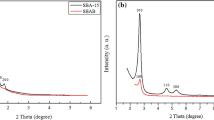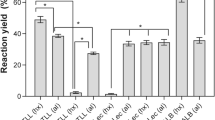Abstract
The hydrolysis of edible oil by immobilized lipases on novel support materials was investigated. Six hydrophobic polymers were studied with the following techniques: (i) determination of the surface area of each support by BET (Brunauer-Emmett-Teller) analysis of nitrogen adsorption isotherms; (ii) electron photomicrography; and (iii) measuring lipase activity by hydrolysis of olive oil with lipase fromCandida cylindracea immobilized on each support. A detailed structural analysis on one support also was carried out by mercury porosimetry. The composition and porosity of a support are more important than the surface area in determining activity for immobilized lipases. Furthermore, having selected the “most efficient” support, five lipases fromC. cylindracea, Rhizomucor miehei, andPseudomonas cepacia, were immobilized, and their hydrolytic activities were determined at several temperatures and pH values with olive oil and beef tallow as substrates in solvent-free systems. For each parameter, twelve successive 2.5-h hydrolysis reactions were conducted on a laboratory-scale under batch conditions. Lipase AY fromC. cylindracea had the highest hydrolytic activity, in the range of 30–50°C at pH 5.5 with olive oil as the substrate. For beef tallow, lipase PS, fromP. cepacia, displayed the highest activity at 50°C and pH 7.
Similar content being viewed by others
References
Casey, J., and A. Macrae,INFORM 3:203 (1992).
Potts, R.H., and V.J. Mukerheide, inFatty Acids and Their Industrial Applications, edited by E.S. Pattison, Marcel Dekker, New York, 1968, p. 28.
Lie, E., and G. Molin, inConversion of Low Grade Fats by Biological Means, edited by P. Gemeiner, Ellis Horwood, New York and London, 1992, Chapter 13.
Quinlan, P., and S. Moore,INFORM 4:580 (1993).
Malcata, F.X., R.R. Hector, H.S. Garcia and C.G. Hill, Jr.,J. Am. Oil Chem. Soc. 67:890 (1990).
Kennedy, J.F., C.A. White and E.H.M. Melo,Chimicaoggi-Maggio Review:21 (1988).
Gemeiner, P. (ed.), inEnzyme Engineering: Immobilized Biosystems, Ellis Horwood, New York and London, 1992.
Ruthven, D.M., inPrinciples of Adsorption and Adsorption Processes, John Wiley & Sons, Inc., Canada, 1984, p. 53.
Yang, R.T. (ed.), inGas Separation by Adsorption Processes, Butterworths Publishers, Stoneham, 1987, Chapter 2.
Young, D.M., and A.D. Crowell (eds.): inPhysical Adsorption of Gases, Butterworths, London, 1962, p. 190.
Macrae, A.R.,Biochem. Soc. Trans. 17:1146 (1989).
Malcata, F.X., H.G. Garcia, C.G. Hill, Jr. and C.H. Amundson,Biotech. Bioeng. 10:647 (1992).
McIlvaine, T.C.,J. Biol. Chem. 49:183 (1921).
Mosbach, K. (ed.),Methods in Enzymology 44, Academic Press, New York and London, 1976.
Brady, C., L. Metcalfe, D. Slaboszewski and D. Frank,J. Am. Oil Chem. Soc. 65:917 (1988).
Brady, C., L. Metcalfe, D. Slaboszewski and D. Frank, U.S. Patent 4,629,742 (1986).
Peel, R.G., A. Benedek and C.M. Crowe,A.I.Ch.E. J. 27:26 (1981).
Bosley, J., J. Clayton and A. Peilow,INFORM 3:491 (1992).
Bosley, J.A., and J.C. Clayton,Biotechnology and Bioengineering 43:934 (1994).
Al-Duri, B., Mass Transfer Processes in Single and Multicomponent Batch Adsorption Systems, Ph.D. Thesis, Queen’s University of Belfast, Northern Ireland, 1988.
Beck, R.E., and J.S. Schultz,Science 170:1302 (1970).
Dubinin, M.M., inChemistry and Physics of Carbon, Marcel Dekker, New York, 1966.
Benzonana, G., and S. Esposito,Biochim. Biophys. Acta 231:15 (1971).
Author information
Authors and Affiliations
About this article
Cite this article
Al-Duri, B., Robinson, E., McNerlan, S. et al. Hydrolysis of edible oils by lipases immobilized on hydrophobic supports: Effects of internal support structure. J Am Oil Chem Soc 72, 1351–1359 (1995). https://doi.org/10.1007/BF02546211
Received:
Accepted:
Issue Date:
DOI: https://doi.org/10.1007/BF02546211




